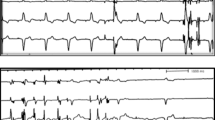Abstract
To avoid the risk of R-on-T incident and the unnecessary decrease of cardiac output, we devised an algorithm consisting of six steps for choosing the most appropriate intraoperative pacemaker (PM) mode, which is modified from Heart Rhythm Society and the American Society of Anesthesiologists expert consensus statement. Following this algorithm, we reviewed previous operations at our hospital to evaluate the appropriateness of the choices. Six of 78 cases (7.7%) were unfit to the algorithm because of an inappropriate mode change. The PM mode was changed preoperatively in four patients, even though the surgical site was under the umbilicus. In one case of the two other cases, the PM mode was changed from AAI to VOO. This case could not be avoided by the previous algorithm of the expert clinical statements. In another case, the anesthesiologist did not change PM mode even though the patient underwent parotidectomy and his heart rate depended on PM. Prospective research on this algorithm could clarify its usefulness in the future. Moreover, discussions about this algorithm could help develop this field of study and improve the intraoperative management of PMs.


Similar content being viewed by others
References
Hearley JS, Merchant R, Simpson C, Tang T, Beardsall M, Tung S, Fraser JA, Long L, Van Vlymen JM, Manninen P, Rally F, Venkatraghavan L, Yee R, Prasloski B, Sanatani S, Philippon F. Canadian Cardiovascular Society; Canadian Anesthesiologists’ Society; Canadian Heart Rhythm Society; Society position statement: Canadian Cardiovascular Society/Canadian Anesthesiologists’ Society/Canadian Heart Rhythm Society joint position statement on the perioperative management of patients with implanted pacemakers, defibrillators, and neurostimulating devices. Can J Cardiol. 2012;28:141–51.
Filipovic M, Michaux I, Seeberger MD. Harm associated with reprogramming pacemakers for surgery. Anesthesiology. 2002;97:1033–4.
Crossley GH, Poole JE, Rozner MA, Asirvatham SJ, Cheng A, Chung MK, Ferguson TB, Gallagher JD, Gold MR, Hoyt RH, Irefin S, Kusumoto FM, Moorman LP, Thompson A. The Heart Rhythm Society (HRS)/AmericanSociety of Anesthesiologists (ASA) Expert Consensus Statement on the perioperative management of patients with implantable defibrillators, pacemakers and arrhythmia monitors: Facilities and patient management this document was developed as a joint project with the American Society of Anesthesiologists (ASA), and in collaboration with the American Heart Association (AHA), and the Society of Thoracic Surgeons (STS). Heart Rhythm. 2011;8:1114–54.
Bernstein AD, Daubert JC, Fletcher RD, Hayes DL, Luderitz B, Reynolds DW, Schoenfeld MH, Sutton R. The revised NAPSE/BPEG generic code for antibradycardia, adaptive-rate, and multisite pacing. North American Society of pacing and electrophysiology/british pacing and electrophysiology group. Pacing Clin Electrophysiol. 2002;25:260–4.
American Society of Anesthesiologists. Practice advisory for the perioperative management of patients with cardiac implantable electronic devices: pacemakers and implantable cardioverter defibrillators: an updated report by the American Society of Anesthesiologists Task Force on perioperative management of patients with cardiac implantable electronic devices. Anesthesiology. 2011;114:247–61.
Stone ME, Salter B, Fischer A. Perioperative management of patients with cardiac implantable electronic devices. Br J Anesthesia. 2011;12:i16–26.
Peter MS, Miriam MT, David Y, Charles AH, Peter MJ, Thomas AD, Matthias JM, Valerie S, Izumi H, Ryan BA, Ed K, Ann B, Nabil A, Eric CS. Electromagnetic interference with protocolized electrosurgery dispersive electrode positioning in patients with implantable cardioverter defibrillators. Anesthesiology. 2019;130:530–40.
Elkayam LU, Koehler JL, Sheldon TJ, Glotzer TV, Rosenthal LS, Lamas GA. The influence of atrial and ventricular pacing on the incidence of atrial fibrillation: a meta-analysis. Pacing Clin Electrophysiol. 2011;34(12):1593–9.
Author information
Authors and Affiliations
Contributions
YT: The collection of the data, the analysis and the preparation of the manuscript. TM: The conception of the work, the interpretation of data, the design of the study, and the preparation of the manuscript. YN: The design of the study. TG: The conception of the work.
Corresponding author
Additional information
Publisher's Note
Springer Nature remains neutral with regard to jurisdictional claims in published maps and institutional affiliations.
About this article
Cite this article
Terada, Y., Miyashita, T., Nagamine, Y. et al. A modified algorithm for choosing the most appropriate intraoperative pacemaker mode for patients with permanent pacemaker in non-cardiac surgery. J Anesth 35, 145–149 (2021). https://doi.org/10.1007/s00540-020-02878-5
Received:
Accepted:
Published:
Issue Date:
DOI: https://doi.org/10.1007/s00540-020-02878-5




